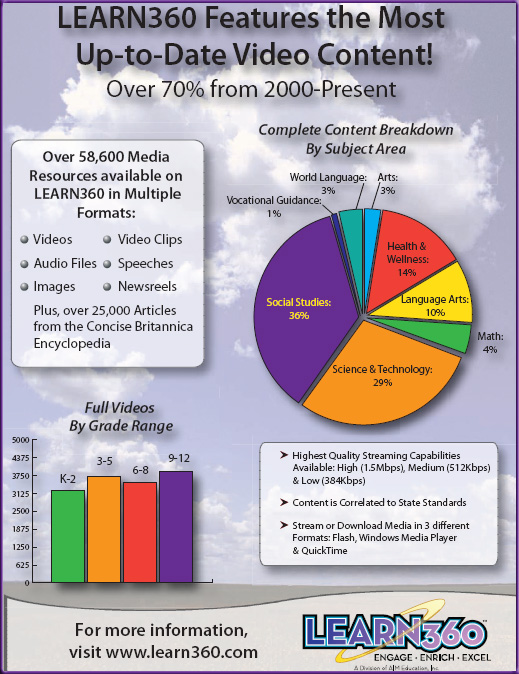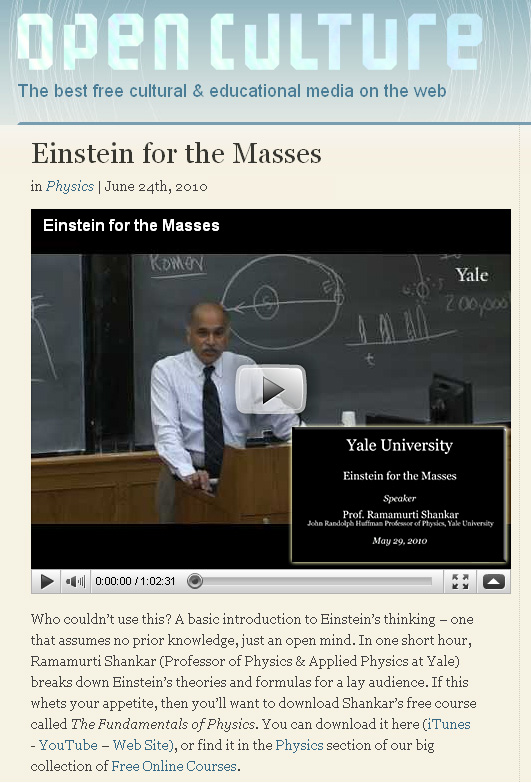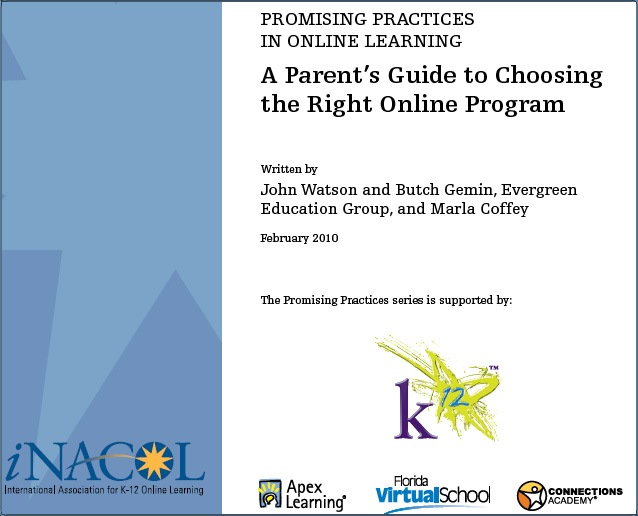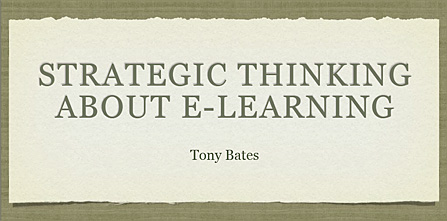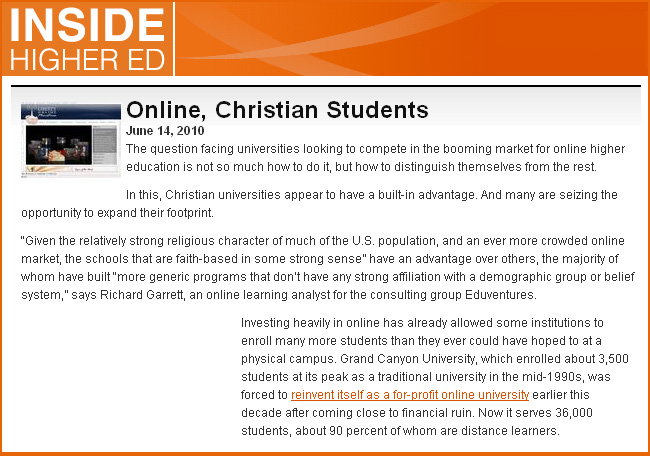Southern Regional Education Board.
http://publications.sreb.org/2006/06T06_Checklist_for_Evaluating-Online-Courses.pdf
The online course evaluation project (OCEP) criteria. Monterey Institute for Technology and Education.
http://alt.usg.edu/collaborative/templates/OnlineCourseEvaluationRubric.pdf
http://www.montereyinstitute.org/pdf/OCEP%20Evaluation%20Categories.pdf
Differentiating learning by ‘learning style’ might not be so wise — from Clayton Christensen
First, some quotes from Clayton:
A study commissioned by Psychological Science in the Public Interest called “Learning Styles: Concepts and Evidence,” by Harold Pashler, Mark McDaniel, Doug Rohrer, and Robert Bjork, finds convincingly that, at this point, there is no evidence that teaching to different learning styles—specifically meaning to a student’s apparent preferred modality such as visual or auditory—works. The authors therefore conclude that using scarce school funds toward doing just this doesn’t make sense.
Of course, there appears to still be some disagreement. According to a March 25, 2009 article in The Journal of Neuroscience titled “The Neural Correlates of Visual and Verbal Cognitive Styles” by David J.M. Kraemer, Lauren M. Rosenberg, and Sharon L. Thompson-Schill, there is some evidence that teaching by learning style could make a difference.
Moving outside of this particular debate, this doesn’t change the fundamental point that people learn differently. People don’t disagree with this. There is clear evidence that that people learn at different paces. Some people understand a concept quickly. Others struggle with it for some time before they understand it. We know that explaining a concept one way works well for some people, and explaining it another way works for others whereas it baffles the first group. We also know that this can differ from person to person depending on subject area. One of the key reasons online learning seems to be better on average than face-to-face learning is because time can become variable in an online learning environment so that students can repeat units and lectures until they master a concept and only then move on to the next concept.
From DSC:
What’s the best way(s) to apply all of this? What makes the most sense in how we operationalize the delivery of our content? In my studies on instructional design, there are so many theories and so much disagreement as to how people learn. If you ask for consensus, you won’t get it. So my conclusion is this:
Provide the same content in as many different ways as you possibly can afford to provide. Let the students choose which item(s) work best for them and connect with them. If one way doesn’t connect, perhaps another one will.
Also…yes, we can probably all learn from just text if we have to. But was learning fun that way? Was it engaging? Was it the most effective it could have been? Was learning maximized for the long-haul? Would it have been helpful to see the same content in a graphic, simulation, animation, or in a video?
Below are some resources for learning languages — online
http://www.wimba.com/products/wimba_voice/
http://www.italki.com/
http://www.forvo.com/languages/
http://www.unilang.org/
http://universitiesandcolleges.org/language-learning-resources/
http://www.byki.com/
http://www.livemocha.com/
http://www.learn10.com/
http://www.c4lpt.co.uk/Showcase/100langlearning.html
http://www.rosettastone.comhttp://www.bbc.co.uk/languages/
http://2bdutch.nl/
http://www.wordreference.com/
http://www.voorleesbijbel.nl/
http://how-to-learn-any-language.com/e/languages/index.html
http://www.radiolinguaschools.com/information/intro/
http://www.digitaldialects.com/index.htm
http://www.mguhlin.org/2009/12/book-reflection-moodle-19-for-second.html
Free Online Language Translation: Best Services To Translate Your Documents – Mini-Guide:
http://www.masternewmedia.org/free-online-language-translation-best-services-to-translate-your-documents-mini-guide/
http://www.mingoville.com/en.html
http://www.byki.com/lists/LATIN/Teach-Yourself-Beginner-s-Latin-UNIT-4-phrases.html
http://beelinetv.com/
http://www.mylanguagenotebook.com/
http://www.lexiophiles.com/language-blog-toplist/top-100-language-blogs-2009-nominated-blogs-language-learning
http://www.babelwith.me/
http://www.babbel.com/
http://clear.msu.edu/clear/store/products.php
http://dotsub.com/
Ten Excellent Language Translators And Resources:
http://www.informationweek.com/blog/main/archives/2008/12/ten_excellent_l.html
From http://magistram.wordpress.com/2010/04/02/digital-storytelling-with-voicethread/
In our Latin 1 classes, we start the year by asking our students to find examples of Latin mottos or phrases that are still in use today. This year we used VoiceThread to again add the oral element to the presentation. Most of the presentations were created using either PowerPoint or SMART Notebook. Then the images were uploaded to VoiceThread and students recorded their comments there. Students selected mottos that all followed a certain theme, then chose images that best illustrated the motto. Some examples of this project are: Latin Love Mottos, and Philosophical Latin Mottos.
Also see:
http://voicethread.com/#q.b908650.i4836718
…
Some flash card related sites:
- http://www.flashcardexchange.com
- http://www.flashcardmachine.com
- http://www.proprofs.com/flashcards
E-Learning Journals — from e-taalim.com[via S. Downes]
Steps for creating and growing your online program — from Faculty Focus by Mary Bart
1: Define your purpose for having an online program
High-quality online programs require a significant upfront investment, and should align with the mission of the university. As a result, it’s important that you’re able to articulate why you want to put a program online. As you develop your business plan and budget, be sure to include a timeline, a realistic assessment of available resources, and metrics for success.
2: Assign an administrative leader
The institution needs to designate an administrative leader who can manage all aspects of program development and delivery. This person needs to understand “the big picture” while coordinating with deans, faculty, instructional designers, support services, library personnel, and others who play a role in the online students’ learning experience, Williams says.
3: Create faculty buy-in
Many faculty feel teaching online is inferior to teaching face-to-face. Williams works hard to dispel those and other myths. She also recommends starting with faculty who are known as innovators on campus, and providing a workload and compensation plan that recognizes the additional time and effort required to design an online course. Providing support from instructional designers is critical as well, she says.
4: Build online student support services
Because many online students may never set foot on campus, all the normal functions related to financial aid, registration, billing, library, and technology support must be available online.
5: Consider outsourcing
Many smaller universities are stretched thin when it comes to marketing and admissions. Adding online programs to their job responsibilities may be a tough sell, and likely won’t get you the results you want. Williams suggests outsourcing these tasks to vendors who specialize in adult learners and online education.

Also see:
Governor Daniels Announces New Online University for Indiana
Executive Order establishes charter for WGU Indiana, the state’s first competency-based university
Indianapolis — Governor Mitch Daniels today announced the establishment of WGU Indiana, http://indiana.wgu.edu, a new online, competency-based university aimed at expanding access to higher education for Hoosiers. Formed by a partnership between the state and Western Governors University, the nation’s only non-profit, competency-based university, WGU Indiana offers fully accredited bachelor’s and master’s degrees in business, teacher education, information technology, and health professions, including nursing.
Indiana Forms Branch of National Online University — from The Chronicle by Marc Parry
Indiana will create a new branch of a national online institution, Western Governors University, under a deal that state leaders announced on Friday.
“Today we mark the beginning of, in a real sense, Indiana’s eighth state university,” Governor Mitch Daniels said in a prepared statement.
The agreement gives a boost to Western Governors’ model of competency-based education, in which students advance by showing what they’ve learned, not how much time they’ve spent in class. Students can also fast-forward their degrees by testing out of stuff they’ve already mastered.
(Emphasis below from DSC:)
“More and more Christian schools I know through connections, if they’re not already doing [online education], they’re talking about it,” says Shoe, the Mid-America enrollment executive. “And the market’s demanding it.”
The combination of America’s religious character, its large and well-organized evangelical population, its sophisticated online education market, and the big-tent approach to Christian education taken by many of its faith-based universities has set the stage for rapid expansion of Christian-oriented distance learning, says Garrett, whose firm has worked with universities such as Liberty and Mid-America on their online strategies.
…
“I think that evangelicals tend, very often, to look at numbers as being important,” Campo says. Being able to increase the number of Christian-educated graduates in the world via the scale afforded by online education, he says, is cause for enthusiasm in many evangelical circles.
But to what degree can a Christian university actually foster the same religious character in its online students as it can in its residential students?
The task is not as daunting as it was even five years ago, says Kathy Player, the president of Grand Canyon University. “Nowadays, with technology, you can bring in so much of what you do [on campus],” she says. For example, Grand Canyon offers its online students Bible study sessions with a chaplain through its learning-management system.
It also streams its chapel services, as do many similar institutions. They also often pepper their learning portals with inspirational passages from scripture, and provide channels for online students to submit prayer requests from their fellow students. Institutions that require faculty to sign a statement of faith and instruct them to teach various subjects through the prism of Christianity tend to require the same of their online instructors. Regent University offers special training to its online faculty on how to replicate a Christianity-flavored course in an online environment.









